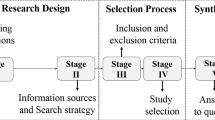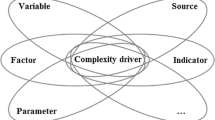Abstract
Conceptual models have proven to be a technique that, from a point of view of the transmission of an idea, facilitates the elaboration of a coherent structure to support the visualization and understanding of a process. The objective of this article is to design a model that supports the application of mathematical models, providing relevant, structured and organized information and helping manufacturing decision makers with a greater procedural understanding. Methodologically, three views were constructed, one physical, functional and the other informational, in order to have clarity of the elements and characteristics in the measurement of complexity, from a subjective perspective with the complexity index (CXI) method and objectively with the Shannon’s entropy model. The findings provide answers to the hypotheses raised, which corroborate that the conceptual models support and ensure a greater understanding and comprehension for the measurement of complex scenarios. At the same time, the structured elaboration of a hybrid model based on heuristics of complexity indexes and entropic measurements is evidenced.
Access this chapter
Tax calculation will be finalised at checkout
Purchases are for personal use only
Similar content being viewed by others
References
J. McDuffie, K. Sethuraman, M. Fisher, Product variety and manufacturing performance: evidence from the international automotive assembly plant study. Manage. Sci. 42(3), 350–369 (1996). https://doi.org/10.2307/2634348
C. Bozarth, D. Warsing, B. Flynn, E. Flynn, The impact of supply chain complexity on manufacturing plant performance. J. Oper. Manag. 27(1), 78–93 (2009). https://doi.org/10.1016/j.jom.2008.07.003
I. Manuj, F. Sahin, A model of supply chain and supply chain decision making complexity. Int. J. Phys. Distrib. Logist. Manag. 41(5), 511–549 (2011). https://doi.org/10.1108/09600031111138844
L. Salum, The cellular manufacturing layout problem. Int. J. Prod. Res. 38(5), 1053–1069 (2000). https://doi.org/10.1080/002075400189013
F. Valero, F. Esteban, A. García, D. Perales, Propuesta de marco conceptual para el modelado del proceso de planificación colaborativa de operaciones en contextos de Redes de Suministro/Distribución (RdS/D), in XI Congreso de Ingeniería de Organización (2007), pp. 0873–0882
F. Lario, D. Pérez, Gestión de Redes de Suministro (GRdS): sus Tipologías y Clasificaciones. Modelos de Referencia Conceptuales y Analíticos, in IX Congreso de Ingeniería de Organización, Gijón (2005), p. 163
B. Wilson, Systems: Concepts, Methodologies and Applications (Wiley, New York, 1984)
G. Chryssolouris, Manufacturing Systems: Theory and Practice, 2nd edn. (Springer, New York, 2006)
S. Heragu, A. Kusiak, Machine layout problem in flexible manufacturing systems. Oper. Res. 36(2), 258–268 (1988). https://doi.org/10.1287/opre.36.2.258
R. Meller, K. Gau, The facility layout problem: recent and emerging trends and perspectives. J. Manuf. Syst. 15(5), 351–366 (1996). https://doi.org/10.1287/opre.36.2.258
S. Li, S. Rao, T. Ragu, B. Nathan, Development and validation of a measurement instrument for studying supply chain management practices. J. Oper. Manag. 23(6), 618–641 (2005). https://doi.org/10.1016/j.jom.2005.01.002
G. Frizelle, E. Woodcock, Measuring complexity as an aid to developing operational strategy. Int. J. Oper. Prod. Manag. 15(5), 26–39 (1995). https://doi.org/10.1108/01443579510083640
K. Efthymiou, A. Pagoropoulos, N. Papakostas, D. Mourtzis, G. Chryssolouris, Manufacturing systems complexity: an assessment of manufacturing performance indicators unpredictability. CIRP J. Manuf. Sci. Technol. 7(4), 324–334 (2014). https://doi.org/10.1016/j.cirpj.2014.07.003
C. Vidal, M. Goetschalckx, Strategic production-distribution models: a critical review with emphasis on global supply chain models. Eur. J. Oper. Res. 98(1), 1–18 (1997)
J. Tang, D. Shee, T. Tang, A conceptual model for interactive buyer-supplier relationship in electronic commerce. Int. J. Inf. Manage. 21, 49–68 (2001)
J. Hernández, J. Mula, F. Ferriols, R. Poler, A conceptual model for the production and transport planning process: an application to the automobile sector. Comput. Ind. 59(8), 842–852 (2008)
M. Perona, G. Miragliotta, Complexity management and supply chain performance assessment. A field study and a conceptual framework. Int. J. Prod. Econ. 90(1), 103–115 (2004). https://doi.org/10.1016/S0925-5273(02)00482-6
M. Haumann, H. Westermann, S. Seifert, S. Butzer, Managing complexity: a methodology, exemplified by the industrial sector of remanufacturing, in Proceedings of the 5th International Swedish Production Symposium SPS, vol. 12 (2012), pp. 107–114
V. Modrak, D. Marton, Structural complexity of assembly supply chains: a theoretical framework. Procedia CIRP 7, 43–48 (2013). https://doi.org/10.1016/fj.procir.2013.05.008
S. Mattsson, P. Gullander, A. Davidsson, Method for measuring production complexity, in 28th International Manufacturing Conference (2011)
D. Eckstein, M. Goellner, C. Blome, M. Henke, The performance impact of supply chain agility and supply chain adaptability: the moderating effect of product complexity. Int. J. Prod. Res. 53(10), 3028–3046 (2015)
R. Urbanic, W. ElMaraghy, Modeling of Manufacturing Process Complexity, vol. VII (2006)
M. De La Fuente, L. Lorenzo, A. Ortiz, Enterprise modelling methodology for forward and reverse supply chain flows integration. Comput. Ind. 61(7), 702–710 (2010)
M. Alemany, M. Verdecho, F. Alarcón, Graphical modelling of the physical organization view for the collaborative planning process, in II ICIEIM, Burgos, 3–5 de Septiembre de 2008
B. Flynn, E. Flynn, Information-processing alternatives for coping with manufacturing environment complexity. Decis. Sci. 30(4), 1021–1052 (1999). https://doi.org/10.1111/j.1540-5915.1999.tb00917.x
S. Sivadasan, J. Efstathiou, A. Calinescu, L. Huatuco, Advances on measuring the operational complexity of supplier–customer systems. Eur. J. Oper. Res. 171(1), 208–226 (2006). https://doi.org/10.1016/j.ejor.2004.08.032
G. Schuh, Lean Innovation (Springer, Berlin, 2013)
L. Gaio, F. Gino, E. Zaninotto, I sistemi di produzione (Edizioni Carocci, Roma, 2002)
N. Suh, A Theory of Complexity and Applications (Oxford University Press, Oxford, 2005)
N. Papakostas, K. Efthymiou, D. Mourtzis, G. Chryssolouris, Modelling the complexity of manufacturing systems using nonlinear dynamics approaches. CIRP Ann. Manuf. Technol. 58(1), 437–440 (2009). https://doi.org/10.1016/j.cirp.2009.03.032
R. Cao, Introducción a la Simulación y a la Teoría de Colas (Ed. Netbiblo S. L. R., 2002)
A. Deshmukh, J. Talavage, M. Barash, Complexity in manufacturing systems. Part 1: Analysis of static complexity. IIE Trans. 30(7), 645–655 (1998). https://doi.org/10.1023/A:1007542328011
G. Vidal, J. Hernández, Complexity in manufacturing systems: a literature review. Prod. Eng. 1–13 (2021)
G. Vidal, J. Hernández, Study of the effects of complexity on the manufacturing sector. Prod. Eng. 1–10 (2021)
J. Aelker, T. Bauernhansl, H. Ehm, Managing complexity in supply chains: a discussion of current approaches on the example of the semiconductor industry. Procedia CIRP 7, 79–84 (2013). https://doi.org/10.1016/j.procir.2013.05.014
Author information
Authors and Affiliations
Corresponding author
Editor information
Editors and Affiliations
Rights and permissions
Copyright information
© 2022 The Author(s), under exclusive license to Springer Nature Singapore Pte Ltd.
About this paper
Cite this paper
Vidal, G.H., Coronado-Hernández, J.R., Niebles, A.C.P. (2022). Conceptual Model for Measuring Complexity in Manufacturing Systems. In: Poonia, R.C., Singh, V., Singh Jat, D., Diván, M.J., Khan, M.S. (eds) Proceedings of Third International Conference on Sustainable Computing. Advances in Intelligent Systems and Computing, vol 1404. Springer, Singapore. https://doi.org/10.1007/978-981-16-4538-9_19
Download citation
DOI: https://doi.org/10.1007/978-981-16-4538-9_19
Published:
Publisher Name: Springer, Singapore
Print ISBN: 978-981-16-4537-2
Online ISBN: 978-981-16-4538-9
eBook Packages: Intelligent Technologies and RoboticsIntelligent Technologies and Robotics (R0)




